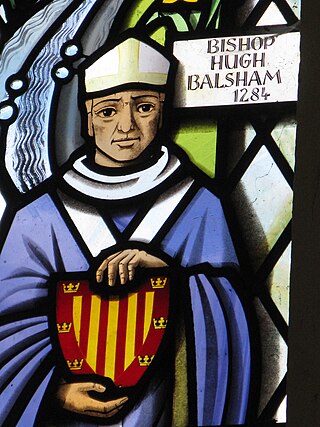Related Research Articles

Hugh de Balsham was a medieval English bishop.
Robert Burnell was an English bishop who served as Lord Chancellor of England from 1274 to 1292. A native of Shropshire, he served as a minor royal official before entering into the service of Prince Edward, the future King Edward I of England. When Edward went on the Eighth Crusade in 1270, Burnell stayed in England to secure the prince's interests. He served as regent after the death of King Henry III of England while Edward was still on crusade. He was twice elected Archbishop of Canterbury, but his personal life—which included a long-term mistress who was rumoured to have borne him four sons—prevented his confirmation by the papacy. In 1275 Burnell was elected Bishop of Bath and Wells, after Edward had appointed him Lord Chancellor in 1274.
Robert Winchelsey was an English Catholic theologian and Archbishop of Canterbury. He studied at the universities of Paris and Oxford, and later taught at both. Influenced by Thomas Aquinas, he was a scholastic theologian.
Geoffrey Rufus, also called Galfrid Rufus was a medieval Bishop of Durham and Lord Chancellor of England.

Antony Bek was a bishop of Durham and the Patriarch of Jerusalem.
Philip of Poitou was Bishop of Durham from 1197 to 1208, and prior to this Archdeacon of Canterbury.
John Kirkby was an English ecclesiastic and statesman.
Henry Murdac was abbot of Fountains Abbey and Archbishop of York in medieval England.
William de Wickwane was Archbishop of York, between the years 1279 and 1285.
William of St. Barbara or William of Ste Barbe was a medieval Bishop of Durham.
Nicholas Farnham was a medieval Bishop of Durham.
Walter of Kirkham was a medieval English official who held the positions of Keeper of the Wardrobe, Dean of York, and Bishop of Durham. He was elected bishop over Aymer de Valence, 2nd Earl of Pembroke, the brother of King Henry III. As bishop, he was instrumental in the founding of Balliol College in the University of Oxford.
Robert Stitchill was a medieval Bishop of Durham in England.
William Langton was a medieval English priest and nephew of Archbishop Walter de Gray. William was selected but never consecrated as Archbishop of York and Bishop of Carlisle.
Hugh of Beaulieu was a medieval English Bishop of Carlisle.
Ranulf of Wareham was a medieval Bishop of Chichester.

William of Louth, also known as William de Luda was a medieval Bishop of Ely.

Richard Swinefield was a medieval Bishop of Hereford, England. He graduated doctor of divinity before holding a number of ecclesiastical offices, including that of Archdeacon of London. As a bishop, he dedicated considerable efforts to securing the canonisation of Thomas de Cantilupe, his predecessor, for whom he had worked during his lifetime. Active in his diocese, he devoted little time to politics. He was buried in Hereford Cathedral where a memorial to his memory still stands.
William Scot was a medieval Bishop of Durham-elect.

Richard Marsh, also called Richard de Marisco, served as Lord Chancellor of England and Bishop of Durham.
References
- Carver, M. O. H. (1980). "Early Medieval Durham: the Archaeological Evidence". Medieval Art and Architecture at Durham Cathedral. British Archaeological Association Conference Transactions for the year 1977. Leeds, UK: British Archaeological Association. pp. 11–19. OCLC 13464190.
- Fryde, E. B.; Greenway, D. E.; Porter, S.; Roy, I. (1996). Handbook of British Chronology (Third revised ed.). Cambridge, UK: Cambridge University Press. ISBN 0-521-56350-X.
- Greenway, Diana E. (1971). "Durham: Bishops". Fasti Ecclesiae Anglicanae 1066-1300. Vol. 2: Monastic Cathedrals (Northern and Southern Provinces). Institute of Historical Research. Retrieved 25 October 2007.
- Moorman, John R. H. (1955). Church Life in England in the Thirteenth Century (Revised ed.). Cambridge: Cambridge University Press. OCLC 213820968.
- Piper, A. J. (2004). "Holy Island, Robert of [Robert de Insula]". Oxford Dictionary of National Biography (online ed.). Oxford University Press. doi:10.1093/ref:odnb/14434.(Subscription or UK public library membership required.)